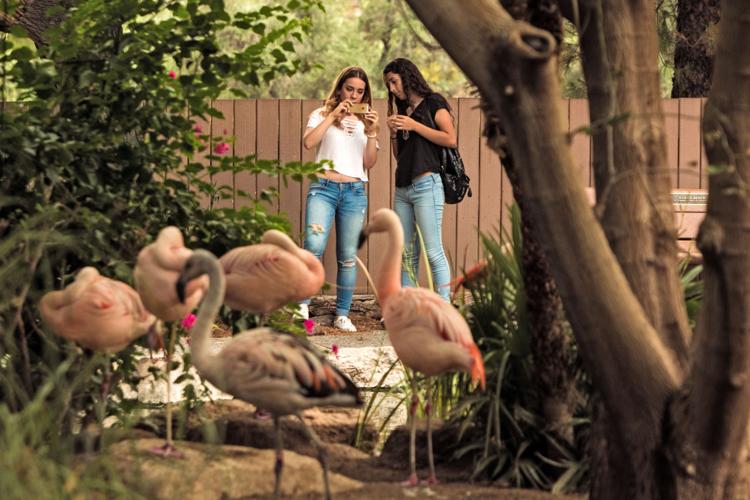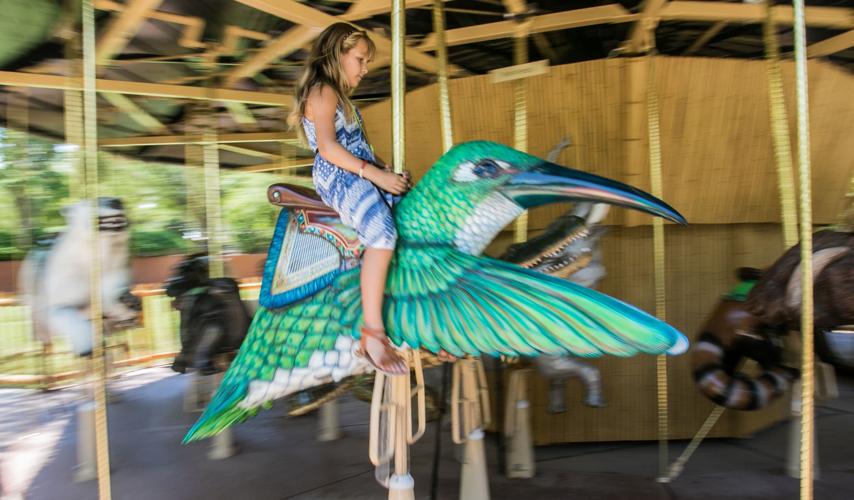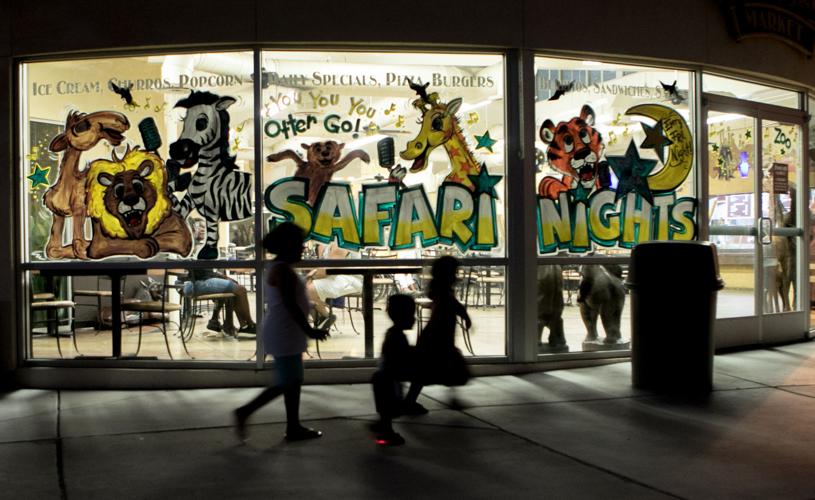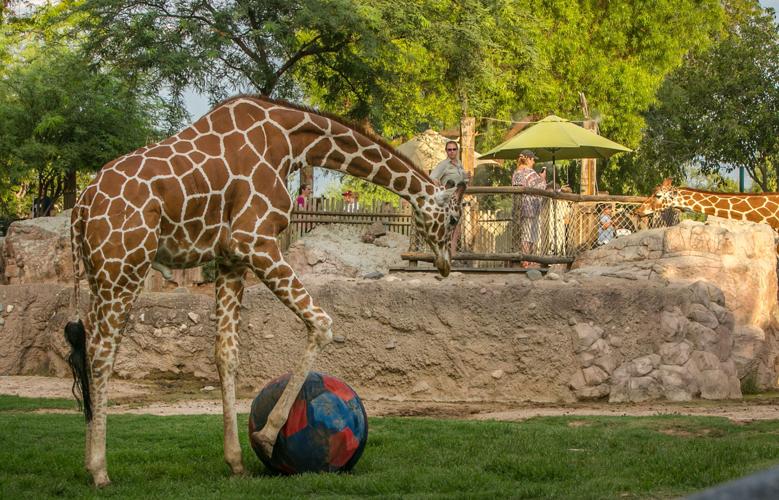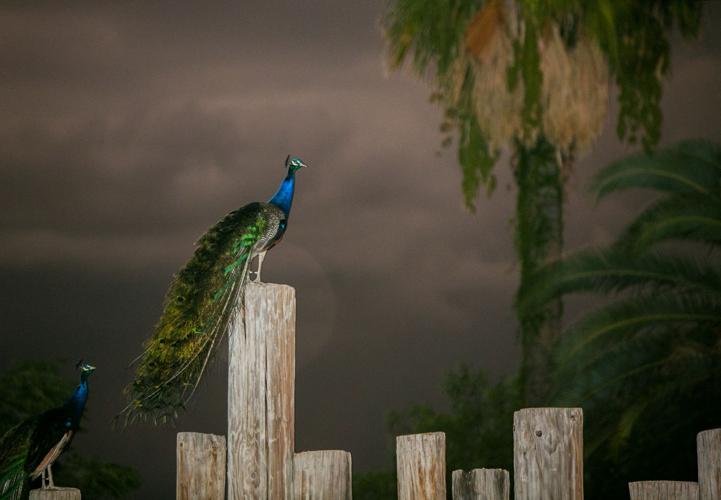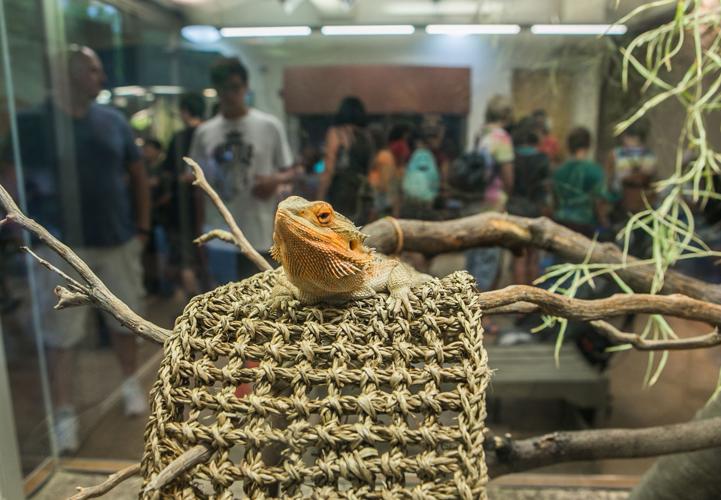There’s a place in Tucson where you can talk to the tigers, greet the giraffes and learn about the lemurs: Reid Park Zoo.
Summers are a good chance to catch the night and day of the zoo — it’s open Friday nights through Aug. 4. It’s also open during the cool of mornings.
We set out to see as much as we could — day, night, and behind the scenes. Here’s what we found:

Friday nights are Summer Safari Nights — a hit with children and their families. The special nights run 6-8 p.m. through Aug. 4.
Nighttime
It’s 6 p.m. on a Friday — a Summer Safari Night at the Reid Park Zoo.
Parents fight the wind from the approaching monsoon as they set up strollers in the parking lot. The bad weather is forgotten when the live sounds of the band Shrimp Chaperone, wafts over them. Just inside the entrance, white tents stand tall in the wind. Nancy Kluge, president of the Reid Park Zoo, greets visitors as they enter.
When they do, they see a whirlwind of activity.
A mid-sized train filled with children chugs through the front gate. The smell of kettle corn lingers in the air. A carousel of alligators, flamingos, and lions — each with a child joyfully on top — spins. Strings of lights hang over a grass field where the band plays and families have set up for picnics. Peacocks wander the park with confidence. If you’re lucky you’ll catch one showing off its feathers, spreading out like a flag of deep blue and green.
At the lion sanctuary, the lioness sits on the top of a wooden staircase. Sprinklers above the habitat imitate the rain that is sure to come later. The lion struts around the enclosure while the lioness remains on her staircase throne, languidly keeping an eye on her world.
Next door, a crowd is entranced as it watches the ring-tailed lemurs play tag. Ropes and high wooden platforms make the enclosure look like an obstacle course.
Adults often take a respite on the many benches scattered throughout the park. As they sit, they keep an eye on the children, who run to the nearest animal attraction.

A giraffes plays with a soccer ball while another grabs a snack from a visitor during the Safari Nights event at the Reid Park Zoo.
“My grandkid practically lives here.” Bob Erwol, a member of the zoo said. “He knows all the animals and enjoys them.”
When dusk approaches, the giraffes are put into their evening habitat— as prey animals, they are more cautious than the others. They flee to their night enclosure before the rain even appears.
As the wind dies down a crash of thunder is heard from across the park. The peacocks ignore the crackling sound and continue to strut freely. It begins to sprinkle. A rainbow appears, brightening a gray sky. The weather pressures the otters to find shelter for the night. The two furry friends run up the artificial stream and into a hollowed-out log in the middle of a grass field.
7:30 and the rain picks up, “We gotta get going,” a mother says to her daughter. Those who thought ahead and brought an umbrella brave the weather until 8, when the park closes.
Couples say goodbye to friends, but their children are not so ready to leave. Some stamp their feet in an effort to stay “just five minutes more.”

A hummingbird carries Brooklyn Dent, 8, around the zoo’s merry-go-round. Camel rides are available on the weekends, and the zoo’s train is usually running.
Daytime
Wednesday, 9 a.m. This is the time of day when the animals are the most active and the heat is bearable.
The music and the lights of Friday night are gone. But enter in the daytime and you see the park is wide open. And the nighttime lines of visitors craning their necks for a view of the animals are gone. When the sun is shining, you get a front-row view.
But it is by no means abandoned. The park still gets a decent crowd, about 600 people a day, according to Jed Dodds, the events and outreach supervisor at the zoo.
On this Wednesday morning, however, there are so few people that you feel those you keep crossing paths with have become your friends.
Outside of the camel habitat, Barbara Conley and her family rest for a moment. The camels take a cue from her and lie down and rest their heads. Conley became a member 15 years ago. “It’s a good place to bring my grandchildren,” she says. “The benefits are amazing.”
Some things are the same as the nighttime: The peacocks still roam the park, even as the heat begins to rise. Others are not so keen about the climbing temperature: animals lie down to nap and families sit on benches to rest in the shade. By 11, sluggish visitors find their way to the exit. The zoo’s doors are still open, but the Tucson sun beats back the crowds.

In the education room, a bearded dragon takes in the crowd during Safari Nights. The zoo will expand if a sales tax increase is approved in November.
Behind the scenes
Jed Dodds, the events and outreach supervisor at the zoo, leads the way to the back of the bear enclosure. He warns not to stand too close to the fence. “The bears have sharp claws, they can poke through the fence,” he explains. He shreds leaves of lettuce and sticks them through the chain link fence just inches from Ronan, the male bear. On the other side of the habitat Finley, the female bear, can be seen in the pool. She sits upright in the water and plays with a gray ball.
The bears came from Wyoming.
“We adopted them from Yellowstone National Forest where they were going to be euthanized,” Dodds says.
Signs are plastered around the attraction — “Don’t feed the bears,” “Hide your food,” “A fed bear is a dead bear.”
Grizzly bears live to be about 30 years old; Ronan and Finley are near 5. The two bears were considered “problematic” because they were searching for food in picnic baskets and coming closer to populated areas. In 2013, the bears escaped a death sentence and came to Tucson.
Dodds jumps in the golf cart and follows a narrow, sometimes bumpy dirt road to the anteater’s enclosure.
He has a fistful of wax worms in his hand, and the critter native to South America takes seconds to slurp them up with his long thin nose.
Dodds points out the anteater’s tail, which extends about 3 feet behind his body and has coarse hair that falls to touch the ground. “When he sleeps he sweeps his tail over his body to hide in plain sight.” Dodds says.
Dodds continues on to the rhino habitat. Fireball, the 15-year-old occupant of the enclosure, greets us at the fence away from the park’s viewing deck where visitors stand.
He recognizes Dodds and trots over to him, bringing to mind a loyal puppy dog. Fireball’s horn is about 2 feet long; it’s almost intimidating as he approaches — that horn looks to be aimed right at you. But he’s gentle. He puts his face parallel with the fence, careful not to poke his horn through. Fireball’s skin is covered in dried mud, courtesy of the mud bath that is part of his habitat. Run a hand over Fireball’s tough grey skin and dried clumps of mud fall off.
Dodds explains that rhinos are fairly easy to care for — the herbivores eat hay and foliage.
Fireball walks over to the front of his habitat to greet visitors of the zoo. He shares his grass field with gazelles. One plays at Fireball’s almost constantly swishing tail; the rhino ignores him; he seems absorbed in the crowds gathered around to watch him. As they are in him.


